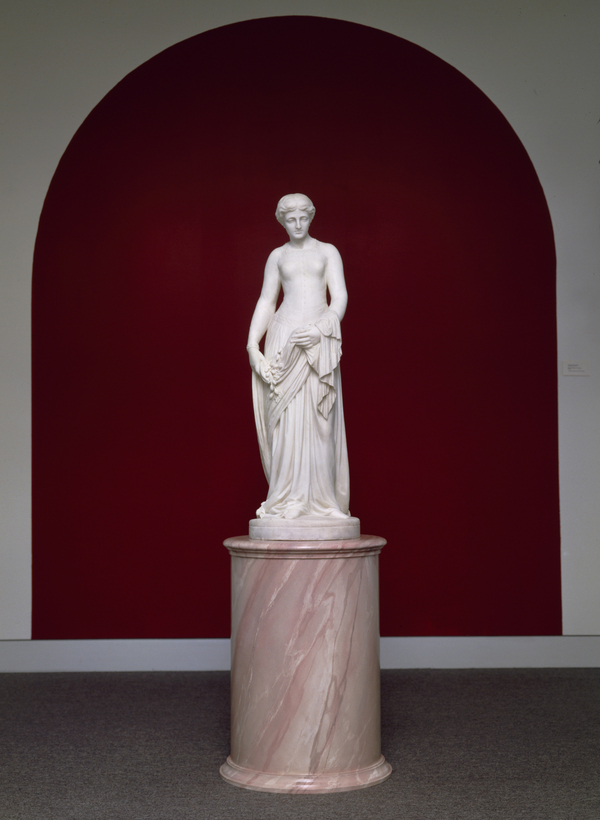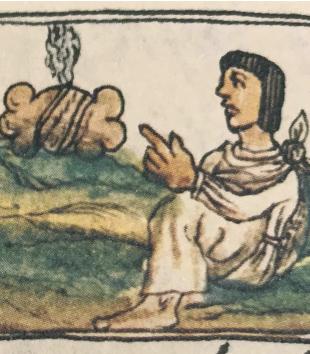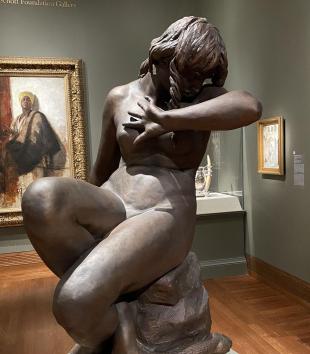In July 1857, a correspondent for the Philadelphia Inquirer visited Benjamin Paul Akers’ studio in Rome. He wrote: “A little statuette of St. Elizabeth of Hungary, at the moment when the bread in her apron was changed to flowers, promises to be very fine; the attitude is graceful and dignified.”1 This clay statuette (which is now lost) served as the basis for at least three large marble versions of St. Elizabeth produced by Akers and his studio assistants between 1859 and 1860, including the sculpture now owned by the Colby College Museum of Art. Akers’ sculpture depicts a thirteenth-century noblewoman who, according to legend, purloined food from her castle’s larder to distribute among the poor. When Elizabeth was intercepted by her husband, who demanded that she reveal what she carried wrapped in her cloak, the stolen loaves were miraculously transformed into roses. Although Akers typically worked in a neoclassical style, St. Elizabeth—with her small head, elongated limbs, elaborate drapery, and sinuously curved posture—is inflected by the Gothic. After the sculptor’s untimely death from tuberculosis in 1861, critics praised this figure as one of his finest productions. Akers’ obituary in the New York Herald states: “In [St. Elizabeth], more than any of his completed works, the most peculiar and rarest qualities of the gifted artist are exhibited.”2 Given the fact that Akers was a Protestant working at a time when nativist and anti-Catholic sentiments ran high in the United States, his choice to depict a miracle performed by an Eastern European saint does indeed seem peculiar, as does the popularity of his sculpture. Two of the original purchasers of St. Elizabeth of Hungary were the New York printing press manufacturer Robert Hoe, Jr. and John Bundy Brown, a sugar refiner from Portland, Maine. Both men were Protestants, yet both proudly displayed Akers’ statue in their homes.3
Akers was born in Maine and worked briefly in Boston and Portland before following the path of other successful American sculptors to Italy. During a visit home in 1858, he met the journalist and poet Elizabeth Chase, whom he later married. Although it is tempting to link Akers’ depiction of St. Elizabeth to his courtship, he had already modeled the figure a year before he met his future wife. The sculptor’s inspiration more likely stemmed from religious images and sculptures that he encountered abroad. Writing home shortly after his arrival in Europe in 1852, Akers expressed his admiration for the works of art he saw in France and Italy, noting: “I was thrown at once from a world where not in all my life had I seen art... into a world where all was art.”4 As John Davis has observed, American Protestants who visited Europe during the antebellum period were often fascinated by Catholic art and ritual. Still, they mistrusted Catholicism’s perceived emphasis on sensory experience over reason.5 Thus, while American artists admired the affecting power exuded by images of Catholic saints, they almost never created such images themselves. Akers’ depiction of St. Elizabeth is a rare exception.
St. Elizabeth of Hungary’s appeal for a Protestant audience can be attributed in part to a popular 1848 drama written by the Anglican priest Charles Kingsley, Jr. In The Saint’s Tragedy: or, The True Story of Elizabeth of Hungary, Landgravine of Thuringia, Saint of the Romish Calendar, Kingsley presented Elizabeth as a pious girl struggling to reconcile her affectionate nature with the harsh demands of the Catholic church. She emerges from his play as an anachronistic, persecuted, and misunderstood Protestant at the mercy of manipulative priests.6 Although the miracle depicted by Akers does not occur in the play, his figure’s mournful expression and his use of period style and costume link the work Kingsley’s purportedly historical drama, making it possible for Americans in the 1850s and 1860s to view this seemingly Catholic statue as an anti-Catholic polemic and to appropriate it for their own spiritual uses. In 1865, an engraving reproducing Akers’ sculpture appeared as the frontispiece in the first issue of Hours at Home, a domestic magazine edited by the Presbyterian minister James Manning Sherwood. In an accompanying account of St. Elizabeth’s life that closely follows the narrative of Kingsley’s play, Sherwood assured his Protestant readers that, while the miracle of the roses was undoubtedly a product of Catholic superstition, the saint’s “real life was a more wonderful miracle than any fabled of her; that highest miracle in this selfish world, a life of pure love toward God and man.”7
Notes
Notes
1. “From Rome, July 1, 1857,” Philadelphia Inquirer, 5 September 1857, 1.
2. “Benjamin Paul Akers, Sculptor,” [New York] Evening Post, 2 August 1861, 1.
3. See Robert Hoe to Benjamin Paul Akers, 13 December 1858, and Benjamin Paul Akers to J. B. Brown, 27 March 1860, Elizabeth Akers Allen Papers, Colby College Libraries, Special Collections. Hoe was a Presbyterian and Brown a Congregationalist.
4. “Benjamin Paul Akers,” American Biography: A New Cyclopedia (New York: The American Historical Society, 1918), 2: 117.
5. John Davis, “Catholic Envy: The Visual Culture of Protestant Desire,” in David Morgan and Sally Promey, eds. The Visual Culture of American Religions (Berkeley: University of California Press, 2001).
6. Charles Kingsley, Jr., The Saint’s Tragedy: or, The True Story of Elizabeth of Hungary, Landgravine of Thuringia, Saint of the Romish Calendar (London: J. W. Parker & Son, 1851; o.p, 1848). See also Devon Fisher, Roman Catholic Saints and Early Victorian Literature: Conservatism, Liberalism, and the Emergence of Secular Culture (Ashgate, 2012), 90-98.
7. [J. M. Sherwood], “Saint Elizabeth of Hungary,” Hours at Home: A Popular Magazine of Religious and Useful Literature 1 (May, 1865), 1.
Keywords
Imprint
10.22332/con.obj.2014.17
1. Lauren Lessing, "Benjamin Paul Akers, St. Elizabeth of Hungary," Object Narrative, in Conversations: An Online Journal of the Center for the Study of Material and Visual Cultures of Religion (2014), doi:10.22332/con.obj.2014.17
Lessing, Lauren. "Benjamin Paul Akers, St. Elizabeth of Hungary." Object Narrative. In Conversations: An Online Journal of the Center for the Study of Material and Visual Cultures of Religion (2014). doi:10.22332/con.obj.2014.17



